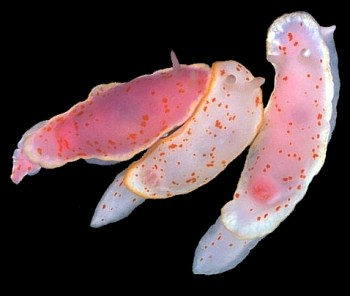
Noumea haliclona
(Burn, 1957)
Order: NUDIBRANCHIA
Suborder: DORIDINA
Superfamily: EUDORIDOIDEA
Family: Chromodorididae
DISTRIBUTION
Southeastern Australia (New South Wales, Victoria, Tasmania)
PHOTO
UPPER RIGHT: Ben Buckler, North Bondi, Sydney, New South Wales. 12m, March 1982. Three colour forms, 12-17mm long.
LOWER LEFT: Flinders, Westernport Bay, Victoria. March 1986. 19mm long.
LOWER RIGHT: Stanley, northern Tasmania. 12m, June, 1985. Three colour forms approx 15mm long alive. PHOTOS: Bill Rudman.
This small chromodorid is common in south eastern Australia both intertidally and sublittorally from northern New South Wales, to Victoria and Tasmania. It is one of the red-spotted colour group of chromodorids from this region and exhibits both colour variation within a region [sympatric variation] & distinctive regional colour forms [allopatric variation], which are illustrated on this page. There are no distinguishing anatomical features between the regional colour morphs. Externally, small scattered red or orange spots, and a red or orange mark on the front of the rhinophore club are the two characters which link these forms together. They feed on a range of pink and yellow aplysillid sponges.
New South Wales colour form: White or pink with small scattered red or orange spots. Gills and rhinophores match the colour of the body, and there is a red or orange mark on the anterior edge of the rhinophore club. There is a bright yellow or orange edge to mantle, but this is sometimes very faint or absent, especially in juveniles.
Victoria Colour form: Body and mantle pink with a white edge to the mantle and scattered small orange-red spots. Red-orange spot on anterior edge of rhinophore club.
Tasmania Colour form: Yellow or shades of Pink, with scattered small orange or red spots. Edge of mantle a translucent watery colour, not opaque white as in Victoria and NSW animals.
NSW specimens have been exhaustively studied (Avern, 1986) and the background colour is presumably genetically based because it is not the result of uptake of sponge pigment. The presence of direct development in this species and a pink colour form throughout its range, would suggest that a southern origin rather than a more recent tropical origin, is more likely for this species. It is possible that the pink Victorian or pink or yellow Tasmanian form is ancestral. Colour in those forms matches exactly their food sponge and can be considered most probably to be cryptic. Similar pink and yellow colour states can be found in the sympatric Verconia verconis. Although the same, or similar, pink and yellow aplysillid sponges are found in NSW, it is of interest that in this region there is also a white colour state, and both pink and white forms have a yellow border. This white state, with red spots and a yellow border is clearly no longer cryptic, and approximates well the predominant red-spotted colour group in this region.
They feed on a range of aplysillid sponges. See separate pages on each regional colour form.
Tasmania; Victoria; New South Wales.
See Mimicry between red spotted species in south-eastern Australia.
References:
• Rudman, W.B. (1983) The Chromodorididae (Opisthobranchia: Mollusca) of the Indo-West Pacific: Chromodoris splendida, C. aspersa and Hypselodoris placida colour groups. Zoological Journal of the Linnean Society, 78: 105-173.
• Rudman, W.B. (1986) The Chromodorididae (Opisthobranchia: Mollusca) of the Indo-West Pacific: Noumea flava colour group. Zoological Journal of the Linnean Society, 88: 377-404.
•Rudman, W.B. (1991) Purpose in Pattern: the evolution of colour in chromodorid nudibranchs. Journal of Molluscan Studies, 57, (T.E. Thompson Memorial Issue):5-21.
•Avern, G.J. (1986) The biology of the nudibranch mollusc Noumea haliclona (Burn, 1957). M.Sc. Thesis, University of Sydney (unpublished).
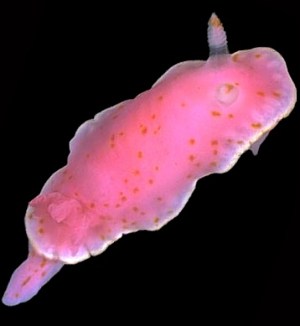
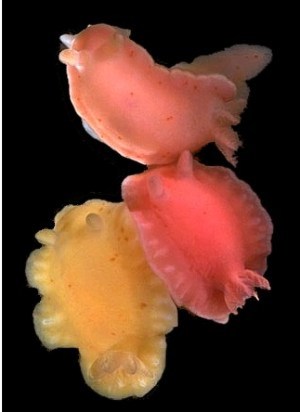
Rudman, W.B., 2000 (May 30) Noumea haliclona (Burn, 1957). [In] Sea Slug Forum. Australian Museum, Sydney. Available from http://www.seaslugforum.net/find/noumhali1
Related messages
Noumea haliclona from Victoria, Australia
August 21, 2006
From: Trevor McMurrich
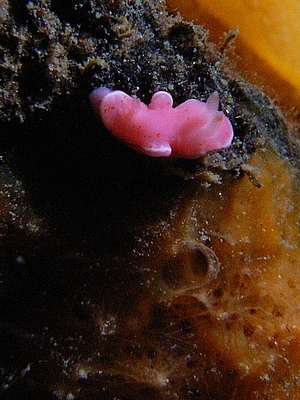
Hi Bill,
I assume this little nudi is a Noumea haliclona but I'm not 100% sure because of the protuberances on its sides. Are they common to the species?
Locality: St Leonards, 3 metres, Victoria, Port Phillip Bay, 23-04-06, pier. Length: 8 mm. Photographer: Trevor McMurrich.
Thank you for your assistance.
Kind regards,
Trevor
trevm@aanet.com.au
McMurrich, T.B., 2006 (Aug 21) Noumea haliclona from Victoria, Australia. [Message in] Sea Slug Forum. Australian Museum, Sydney. Available from http://www.seaslugforum.net/find/17543Dear Trevor,
Yes this is one of the colour forms of Noumea haliclona. The 'protuberance' along each side is just a flod of the mantle edge. Quite a few species of Noumea do this and in some species, such as N. decussata, it is a characteristic of the species. One common colour character found in all the colour forms of N. haliclona is the red or orange spot just below the tip on the front of each rhinophore.
This species use feeds on pink or yellow species of darwinellid sponge. In your photo, the orange-brown sponge in the lower right corner looks like a darwinellid, so it is possible that that is its food sponge as well, so it would be worth keeping an eye out for it on such a sponge.
Best wishes,
Bill Rudman
Noumea haliclona from Victoria, Australia
May 19, 2006
From: Perry Davis

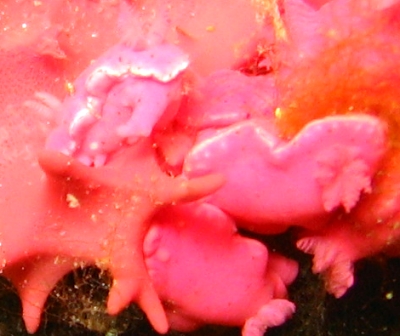
Dear Bill,
I spotted groups of these magnificent nudibranch while diving (12/05/06) in port phillip bay on a pink Darwinella sponge under a pier in about 4 metres of water it was during the day and they were activing grazing. They were very difficult to see and seemed to stay on the pink sponge for camouflage
Locality: Port Phillip Bay, 3-5 metres, Victoria, Australia, 12 May 2006, sandy. Length: 5-10 mm. Photographer: Perry A Davis.
Regards
Perry
marine discovery centre
Queenscliff
vic
perryadavis@bigpond.com
Davis, P.A, 2006 (May 19) Noumea haliclona from Victoria, Australia. [Message in] Sea Slug Forum. Australian Museum, Sydney. Available from http://www.seaslugforum.net/find/16621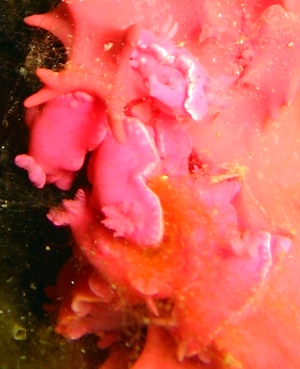
Dear Perry,
This is the chromodorid Noumea haliclona, which you will see from the Fact Sheet has distinct colour forms in different parts of southeastern Australia. It feeds on pink and yellow darwinellid sponges and is often found in clusters or aggregations. The most likely reason for this is that it has direct development, so instead of planktonic swimming veliger larvae hatching out of its egg ribbon, we found small crawling slugs. Since the eggs are usually deposited on the food sponge, or very near by, the young hatch out on to their food and never move very far away. The name 'haliclona' is unfortunate. It was given to the species because its sponge food was misidentified as a species of Haliclona, a species of spiculate sponges which chromodorids don't eat.
Best wishes,
Bill Rudman
Noumea haliclona from South Australia
February 14, 2005
From: Dennis Hutson
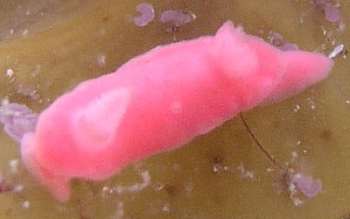
Dear Bill,
Could this please be identified.
Locality: Seacliff Beach, South Australia, Gulf St Vincent, Australia.Depth: 3.5 metres. Length: 5 mm.12 February 2005. Rocky Algal reef. Photographer: Dennis Hutson
Dennis Hutson
dghutson@ozemail.com.au
Hutscon, D.G., 2005 (Feb 14) Noumea haliclona from South Australia. [Message in] Sea Slug Forum. Australian Museum, Sydney. Available from http://www.seaslugforum.net/find/13148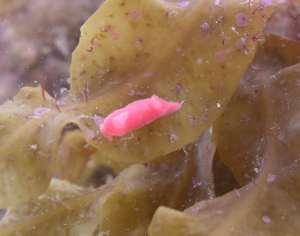
Dear Dennis,
This is interesting on two counts. Firstly, I think it is a juvenile of Noumea haliclona. This is interesting because although it is known from New South Wales, Victoria and Tasmania, this is the first record I know of it from South Australia. As you will see from the Fact Sheet, its colour matches one of the colour forms found in Tasmania.
The second interesting point is that its rhinophores are fused. Instead of being a pair, there is one large central rhinophore apparently in a single large pocket. This is obviously a result of some fault during its larval development. If you are interested, have a look at the Fact Sheet where I have listed other developmental abnormalities
Best wishes,
Bill Rudman
Noumea margaretae? from New South Wales
February 26, 2001
From: Judith Martin
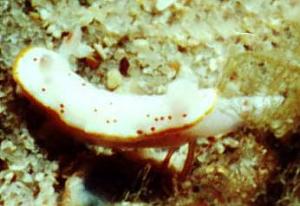
The attached photo was taken at Fly Point, Nelson Bay, New South Wales [Australia] around Christmas. Viz was around 10 meters, water temp around 20c. Depth was 15 meters. This nudi was crawling along the sand and shell grit bottom.The nudi first looked like a Chromodoris daphne, but it's gills and rhinophores are white.
Thank You
Judith Martin
crazydivers@optusnet.com.au
Martin, J., 2001 (Feb 26) Noumea margaretae? from New South Wales. [Message in] Sea Slug Forum. Australian Museum, Sydney. Available from http://www.seaslugforum.net/find/3861Dear Judith,
C. daphne also has both a red and yellow border to the mantle. If you look carefully at the rhinophores in your photo you will see a red spot about midway down the front edge. This is typical of Noumea haliclona and separates it from all the other red-spotted chromodorids in southeastern Australia.
You will see at the top of this page that this species has quite distinct colour variations in different parts of southeastern Australia. In all cases the red spot on the rhinophores is present. Noumea margaretae is a name previously given to the pink colour form from Victoria.
Best wishes,
Bill Rudman
Noumea haliclona from Sydney
June 8, 2000
From: Noel Conlon

Hi Bill,
I photographed these slugs at Kurnell,
Botany Bay NSW in 12 meters of water. They were about 4cm long.
Best wishes
Noel Conlon
diannoel@hotmail.com
Conlon , N., 2000 (Jun 8) Noumea haliclona from Sydney. [Message in] Sea Slug Forum. Australian Museum, Sydney. Available from http://www.seaslugforum.net/find/2470Dear Noel,
I would be surprised if they were 4 cms long as this species normally only grows to about 15mm. It is Noumea haliclona, a common southeastern Australian species which I have avoided adding to the Forum until now because it shows a great amount of colour variation and all the forms need to be described. I have added four pages on this species including separate pages on the different colour forms found in New South Wales, Victoria and Tasmania.
It is a particularly interesting species because the southern colour forms are clearly cryptic, matching the colour of their food, while in New South Wales a white colour form has evolved to mimic the other red-spotted species of chromodorids endemic to the region.
Best wishes,
Bill Rudman.
Colour variation in Noumea haliclona
June 8, 2000
From: Bill Rudman.
I have just added four pages on Noumea haliclona and its regional colour forms. This interesting southeastern Australian endemic has cryptic colour forms matching the colour of its food sponges, in the southern part of its range, but a red-spotted white form in the north, matching the red-spotted chromodorids endemic to that region.
Best wishes,
Bill Rudman.
